
Kevin Jairaj-USA TODAY Sports
I’m writing this article because I’m worried that one of my favorite baseball things is going away. It’s not Shohei doing Shohei stuff, or Mookie Betts nonchalantly doing something that seems impossible when you watch it in slow motion. It’s not even a hipstery, less-popular-but-still-cool thing, like watching Ke’Bryan Hayes charge a tricky grounder. I like all those things, but nothing has given me more joy over the past half-decade than watching Jacob deGrom calmly dissect opposing lineups.
Maybe I’m too hasty to treat this like it’s in the past. The Rangers expect deGrom back in July or August this year – perhaps he’ll hit the mound and pick up right where he left off. Maybe he’ll be even better, though I’m not exactly sure how that would work. But I’m worried, because nothing lasts forever, and deGrom’s impossible peak has already gone on longer than I expected. At some point, he’ll fall back to the pack, and “right after returning from a major surgery” seems like a fairly likely candidate for when that might occur.
I’m afraid that I’ll forget what it was like to see deGrom at his domineering best. So I started looking at some of the stats that he put up during that run, and watching videos of it, and before I knew it, a few hours had passed. It’s just that fun to look at what he’s been doing and marvel. Maybe the fun will continue when he’s back. Maybe his run will extend for years. But just in case, I’m going to take a preemptive look back so that I can show you some GIFs and graphs and tables that drive home just how spectacular deGrom has been.
Here’s one of my favorite graphs to start us out: deGrom’s unique position among the league’s best swing-and-miss artists. When it comes to missing bats when opposing hitters swing, the best starter in baseball is Blake Snell (at least from 2018 to 2023, the range I’ll be looking at for this article). A lot of pitchers with similar skill sets dot the top 10 of that list: Dylan Cease, Shohei Ohtani, and Robbie Ray all make the cut. When batters swing at their offerings, they miss a lot, because plenty of those offerings are ludicrous breaking balls that finish outside the zone by a mile.
There’s another group at the top of the list: the elite swing-and-miss pitchers who do it in the strike zone. Corbin Burnes, Shane McClanahan, Chris Sale, Max Scherzer, and Gerrit Cole all join deGrom in the top 10, and they don’t issue many walks despite their mountain of whiffs. But deGrom stands alone – he’s nearly as good as Snell at missing bats, but walks fewer than half as many batters, fewer than almost anyone in baseball in fact:
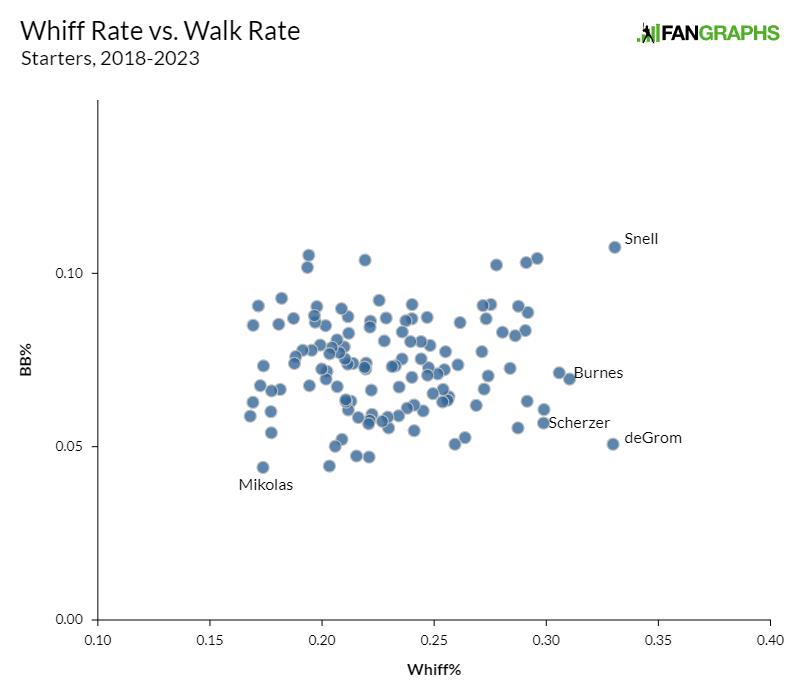
That’s just outrageous. His 5.1% walk rate is sixth in baseball over this stretch, behind a top five of guys you’d expect: Miles Mikolas, Zack Greinke, Hyun Jin Ryu, Ross Stripling, and Kyle Hendricks. Those guys flat out refuse to walk anybody, and they’ll throw hittable pitches in the zone to accomplish their goal: they generate whiffs on 20.4% of swings in aggregate. That’s how you limit walks. There are really no other dots near deGrom; the closest is either Scherzer, with a 29.9% whiff rate and 5.7% walk rate, or Burnes, who checks in at 31.1% and 7%, respectively. In both directions, deGrom is an outlier.
If you separate individual seasons, the chart gets even funnier:
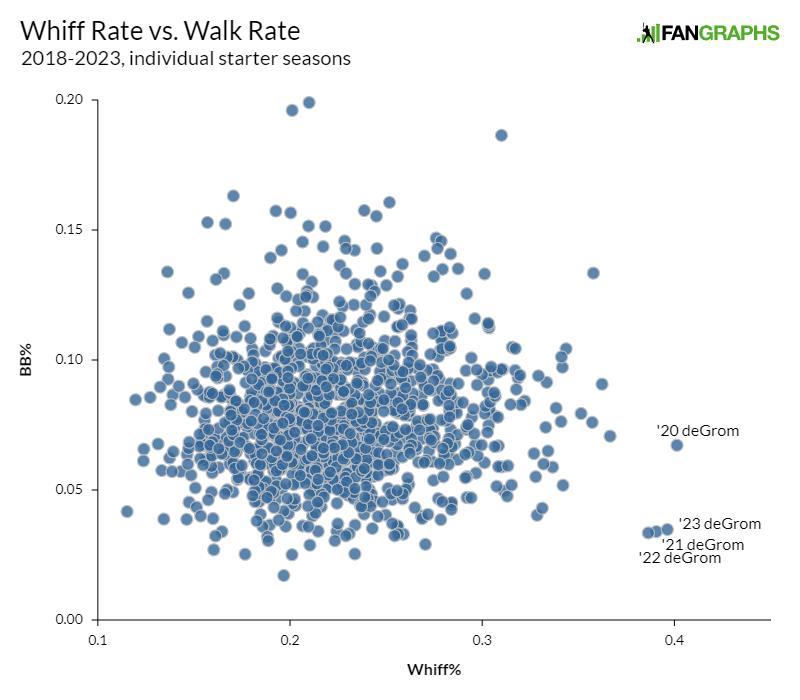
That bottom right cluster is just all deGrom! His last four seasons are the four highest whiff rates in the sample, and he has a 4.3% walk rate over that span. It’s not even clear whether his peers are the low-walk group of the high-whiff group; he’s just more or less the best at both of them.
That’s the key craziness of deGrom’s success: he’s a control artist who just so happens to throw 100 mph. But he’s not just throwing it straight down the middle to avoid issuing walks. Out of the 401 pitchers who threw at least 1,000 pitches from 2018 through 2023, deGrom ranks 319th in the rate at which he throws over the heart of the plate. In other words, 80% of pitchers in baseball throw more middle-middle offerings than deGrom does. That’s not a normal thing for a low-walk pitcher; they mostly attack the zone, naturally enough.
On the other hand, deGrom is adept at dotting the corners of the zone. In that same 401-pitcher group, he ranks 132nd in pitches that are on the borders of the zone, but still in the zone. It’s really hard to do both of those things at once; generally speaking, the easiest way to hit the edges of the zone is if you’re aiming at the center. George Kirby hits the edges of the strike zone more than any other pitcher in baseball. He also hits the heart of the strike zone more than all but six pitchers in baseball. He’s just aiming in the zone, is the point.
For the most part, pitchers who do what deGrom does – fill up the zone without disproportionately attacking the middle – are soft-tossers with impeccable placement. Here are some everyday starters who are better than deGrom at it: Martín Pérez, Ryu, Hendricks, Marco Gonzales, Zach Davies, Tyler Mahle, Zac Gallen, and Zach Eflin. In addition to having a lot of Zac(h)’s, that’s a widely varying group. One thing they all have in common is that their fastballs play up because of that elite command.
Out of that entire group, only Eflin throws his primary fastball harder than league average. Gallen and Mahle are right around the median. Per Stuff+, only Gallen and Mahle have above-average fastballs. Despite that, they have solid fastball results, because they’re locating the pitch where they want it. Then there’s deGrom, who throws an elite closer’s fastball with that kind of command:
Fastball Command Artists
| Pitcher |
vFA |
Stuff+ Fastball |
RV/100 Fastball |
| Zach Davies |
89.3 |
72 |
-0.05 |
| Zac Gallen |
93.5 |
109 |
1.31 |
| Zach Eflin |
94.1 |
98 |
0.49 |
| Tyler Mahle |
93.5 |
110 |
0.36 |
| Hyun Jin Ryu |
90.1 |
85 |
0.52 |
| Kyle Hendricks |
87.4 |
82 |
0.14 |
| Martín Pérez |
93.1 |
80 |
0.48 |
| Marco Gonzales |
88.9 |
96 |
0.52 |
| Jacob deGrom |
97.4 |
139 |
1.63 |
I’m flattering some of the guys in this group by picking the better of their two fastballs. Gonzales, for instance, throws both a sinker and a four-seamer, but his sinker has produced better results, so it’s featured here. Ditto for Pérez. Eflin’s four-seamer has outproduced his sinker, so it’s the one in the table. But deGrom still stands alone, throwing laser beams with the kind of command normally reserved for a completely different type of pitcher.
In fact, deGrom’s fastball is a unicorn of a pitch. He throws it harder than everyone else, of course. Since 2018, his fastball velocity is the fifth-fastest among starters. Since 2020, it’s the fastest, at a gobsmacking 98.9 mph. That’s a great skill for obvious enough reasons – throwing hard is good – but he’s also releasing those laser beams from a shockingly low point:
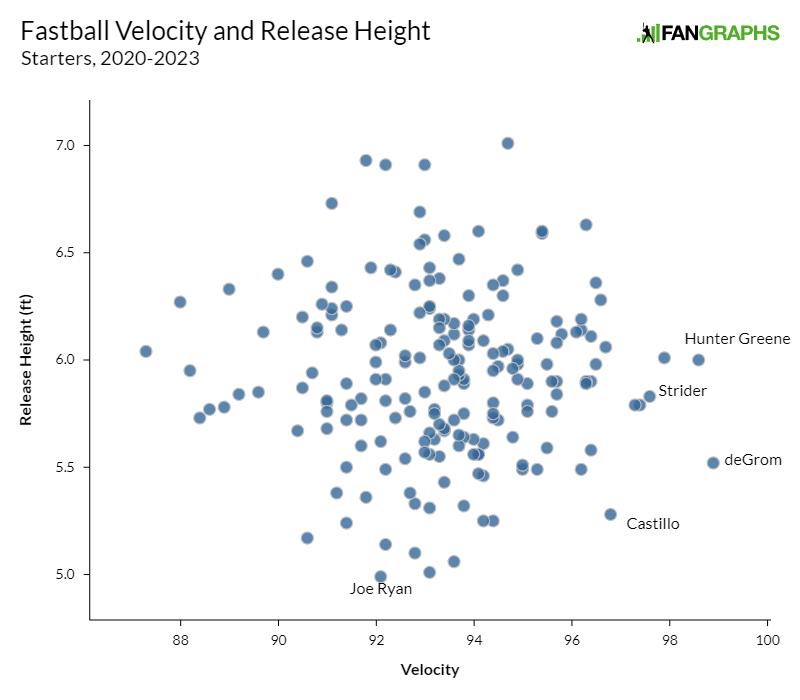
This isn’t a novel observation. Mario Delgado Genzor highlighted Luis Castillo’s ability to do roughly the same thing, firing a four-seamer with plus velocity and movement from a low slot that creates a shockingly flat approach angle. Even that falls short of what deGrom does, though, because Castillo’s fastball doesn’t have the kind of freakish movement profile. On its path home, Castillo’s fastball falls 5.3 inches more than deGrom’s and moves 3.3 more inches sideways.
In action, that means that deGrom’s pitch looks like it defies gravity:
That’s just a straight line from his hand to the catcher, more or less; no wonder Tyler Wade swung under it. In fact, on fastballs at the top of the zone or just above, batters come up empty on 39.9% of their swings against the fastball. That’s an elite rate, sixth in baseball.
Only sixth? That’s disappointing to me, because I thought it might be first, but I’ll have to settle for this: When deGrom absolutely misses his target and throws over the heart of the plate, he still garners a whiff on 25% of swings. That’s the best mark in the game, ahead of Castillo in second. Justin Verlander draws whiffs on 24.8% of swings against his fastballs period, regardless of location. When deGrom misses, he’s basically Verlander – or Tarik Skubal, Pablo López, Carlos Rodón, or any of a number of elite bat missers. That 25% mark would be 27th in baseball for fastball whiff rate overall.
That’s a lot of digital drooling over deGrom’s fastball – but it’s not even his best pitch. That would be his truly unfair slider, which he throws at a heart-stopping 92 mph. It’s an absolutely devastating breaking ball that leaves hitters spinning in circles:
Despite throwing so hard, deGrom commands that slider like he has it on a string – sensing a pattern? The best place to put a breaking pitch is right around the periphery of the plate, in the so-called shadow zone. The best pitcher at this from 2018-2023 was Masahiro Tanaka, who located his slider near the border 46.8% of the time. That’s elite command, and deGrom isn’t far behind at 43.1%, 15th among starters. But of course, Tanaka was doing it at 82-84, not 91-93. Combine devastating speed and movement with elite command, and you yet again have deGrom.
It’s gotten so ridiculous that he doesn’t even use the rest of his arsenal very much – the last time he threw a third pitch even 10% of the time was 2020 (16.9% changeup usage). Naturally, that changeup is devastating, as it, too, comes in over 90 mph, and has some stomach-churning fade:
In fact, per Stuff+, it’s the second-best changeup that any starter throws, fractionally behind Yu Darvish’s version of the pitch. Again, this is his third option, one he’s more or less abandoned in recent years out of a lack of necessity. For what it’s worth, Stuff+ thinks that deGrom has the best four-seamer in the game (Cole’s is second) and the best slider in the game (miles ahead of Lance McCullers Jr., with Cole in third). Just for good measure, the pitch-level model thinks that he has the 10th-best curveball, too, and that’s a pitch he throws less than 5% of the time.
All told, deGrom is unlike pretty much anyone else when it comes to both the quality of his best pitches and the breadth of good options he brings to the table. Here’s a fun chart. This is every starter’s average Stuff+ across all their pitches, as well as the Stuff+ of their weakest offering. Just, what a joke:
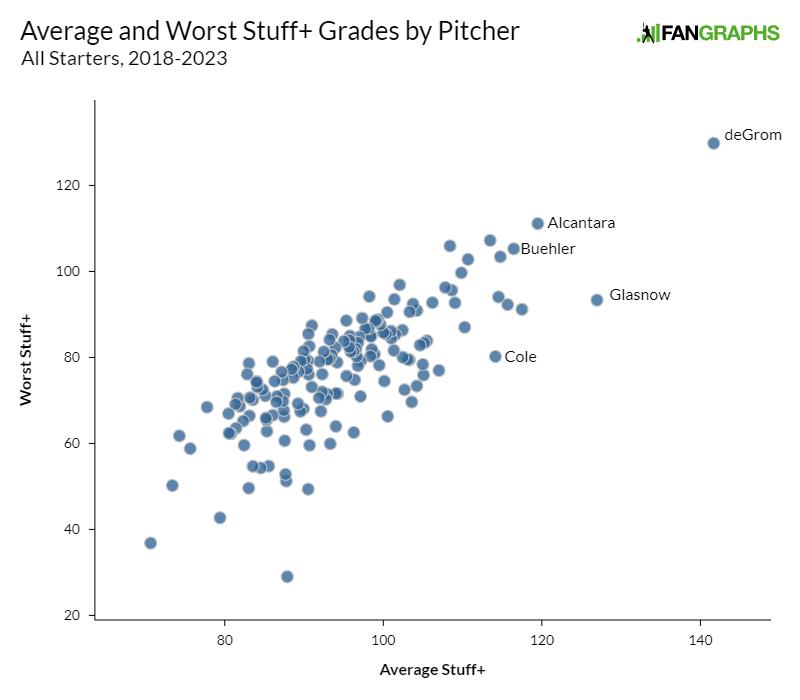
Stuff+ thinks that deGrom’s worst pitch is better, at least in terms of raw stuff, than any other pitcher’s whole arsenal. His curve checks in at 130 – and Tyler Glasnow’s entire pitch mix is second among starters at 127. He’s just operating on a different level. Again, this is only the raw quality of his stuff, not how he commands it, and he’s spectacular on that front as well.
Perhaps, then, we should compare deGrom to relievers. I haven’t even addressed his gaudy strikeout rate yet, but he’s punched out 35.6% of opposing batters starting in 2018, behind only Spencer Strider among starters and Josh Hader among relievers. He’s at 42% – 42%! – starting in 2020. Only Edwin Díaz has been better.
So let’s compare him to relievers, then. I took every pitcher’s WAR from 2018-2023 and converted it into WAR per 100 innings pitched. That puts everyone on a similar scale, so that deGrom’s innings load doesn’t give him an unfair edge over relievers (sure, he’s missed a ton of time with injury, but Adam Ottavino leads all relievers over the span with 351 innings pitched, half deGrom’s tally). Here’s the top 10 by that metric:
Best Inning-for-Inning Pitchers, 2018-2023
| Pitcher |
WAR/100IP |
IP |
| Jacob deGrom |
4.0 |
675.2 |
| Liam Hendriks |
3.6 |
268 |
| Edwin Díaz |
3.3 |
281.2 |
| Spencer Strider |
3.2 |
320.2 |
| Devin Williams |
3.2 |
214 |
| Josh Hader |
3.0 |
341 |
| Max Scherzer |
3.0 |
937.2 |
| Justin Verlander |
2.9 |
780.1 |
| Chris Sale |
2.8 |
456.1 |
| Zack Wheeler |
2.8 |
1007 |
If you’re looking for the very best of the best on a per-inning basis, you should mostly look at relievers. Of note, I didn’t strip out the leverage bonus that our WAR system gives relief pitchers who enter in big spots, so they’re being credited even a little more than you might expect. But regardless, deGrom is the best, better than both all the high-octane bullpen types and the other great starters.
That’s basically the whole idea of this article: Come up with whatever weird criteria you want, and deGrom is probably the best at it. He has elite command. He has elite velocity. All of his pitches are great. He even throws those great pitches from an excellent arm slot to further the effect.
Here’s my last chart of deGrom being better at everything else than everyone else. It’s a boring one, all told: strikeouts and walks. I set the minimums very low: 30 innings pitched as a starter per season. That leaves all kinds of room for fluky, one-off performances. And yet:
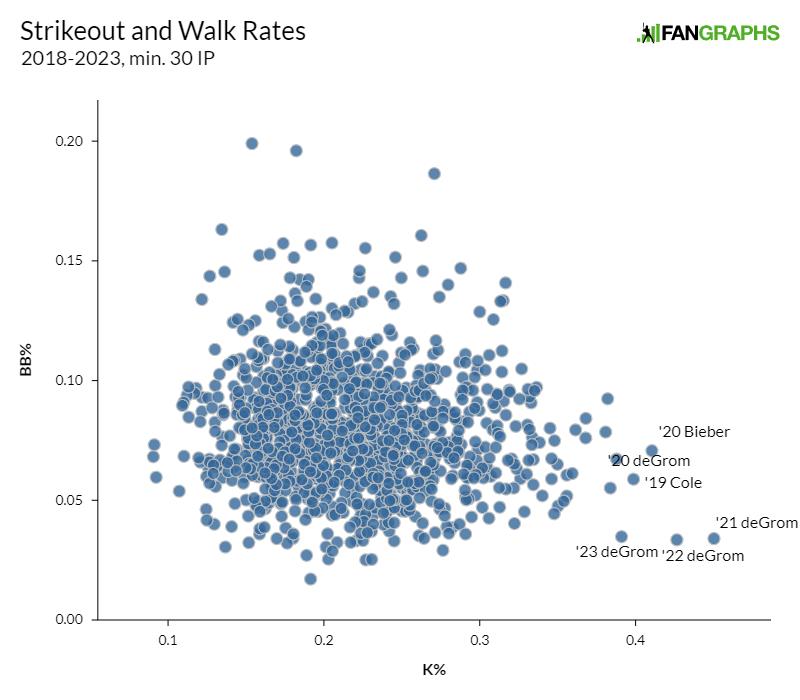
All the good outliers are deGrom. That’s just who he is. No one’s like him. He’s in a completely different stratosphere from the rest of this era’s starters, at least on a per-inning basis. There’s really no comparison; an inning pitched by deGrom is just better than an inning pitched by anyone else. He has a 2.08 ERA in that span. The next-best starter is Verlander at 2.51. His 2.11 FIP is comfortably the best as well. He’s not outperforming his peripherals or anything of the sort; this is just who he is.
Sadly, we haven’t gotten to see that dominance on the mound nearly as often as I’d like. Over that same span, deGrom is fourth among starters in WAR with 27.2, though he’s pitched 400 fewer innings than Cole, who is in first place with 28.5. Availability really matters, and deGrom’s has been poor, to be charitable. He’s burned twice as bright — but for half as long — as many of his contemporaries.
When we look back at him with a bit more remove than we have right now, I think that his availability or lack thereof will be one of the first things people remember. He was a great pitcher, but one who was only intermittently on the mound. That’s true! I wouldn’t argue it for a minute. But I think it’s worth remembering that he isn’t just a garden variety great pitcher. When he pitches, he’s the best pitcher, and it’s by so much that it’s actually laughable. There’s no one else like him. Enjoy the show while you can.
Source
https://blogs.fangraphs.com/jacob-degrom-isnt-like-other-pitchers/
 Backyard GrillingWeekend WarriorsAdvice from DadBeard GroomingTV Shows for Guys4x4 Off-Road CarsMens FashionSports NewsAncient Archeology World NewsPrivacy PolicyTerms And Conditions
Backyard GrillingWeekend WarriorsAdvice from DadBeard GroomingTV Shows for Guys4x4 Off-Road CarsMens FashionSports NewsAncient Archeology World NewsPrivacy PolicyTerms And Conditions
